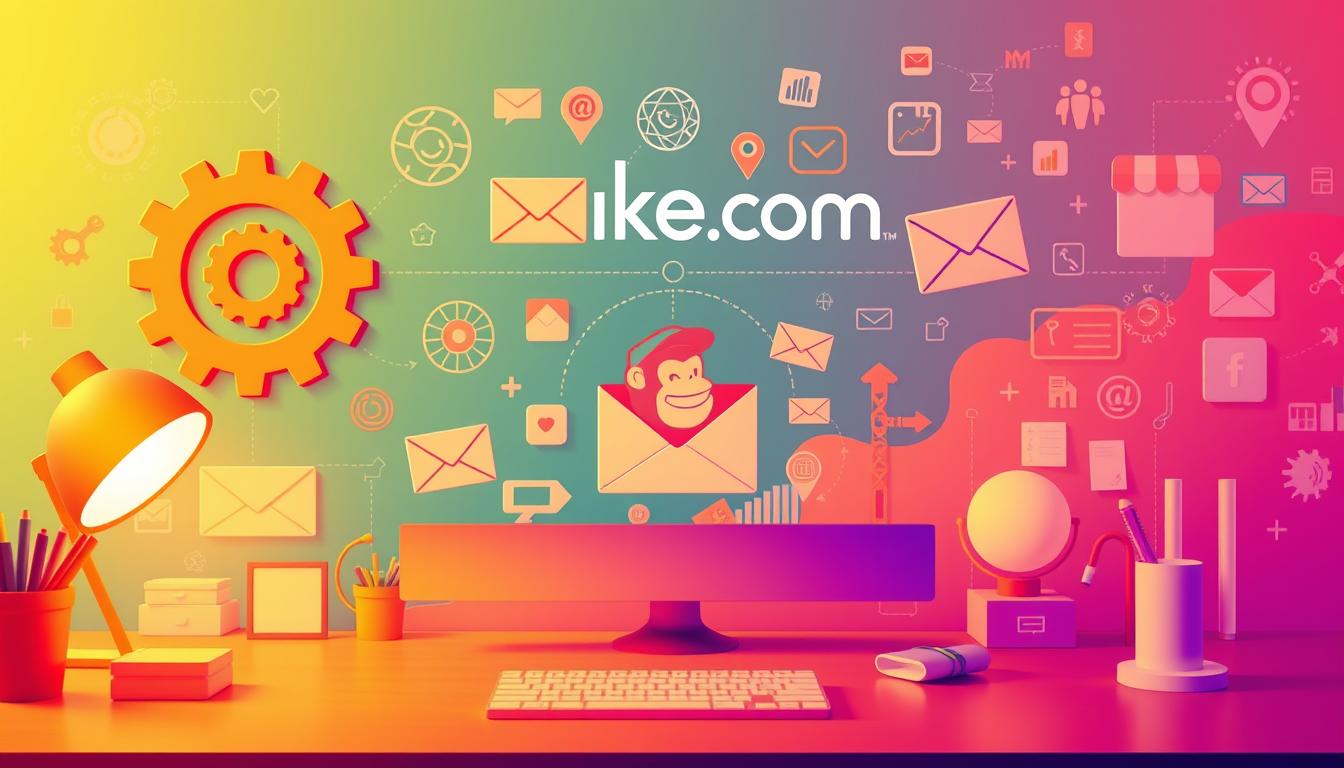Email marketing automation boosts qualified leads by 451% on average. Make.com and Mailchimp offer powerful integrations for small businesses. These tools streamline email marketing and increase campaign efficiency.
As a small business owner, I value maximizing marketing ROI. Make.com and Mailchimp provide a user-friendly platform for automating campaigns. This combination helps nurture leads effectively.
Mailchimp’s pricing fits various business sizes. Plans start at $4.62 monthly for 500 contacts in the Essentials tier. This affordability, paired with Make.com’s automation, appeals to small businesses.
Both platforms have high G2 ratings. Mailchimp scores 4.4 out of 5. Make.com (formerly Integromat) is praised for its intuitive interface. It also offers extensive integration options.
Using these tools together, businesses can create targeted email campaigns. This approach drives engagement and conversions. It’s an effective way to optimize marketing efforts.
Key Takeaways
- Email marketing automation can significantly increase qualified leads for small businesses
- Make.com and Mailchimp offer affordable, user-friendly solutions for automating email campaigns
- Integrating Make.com and Mailchimp allows for targeted, personalized email marketing
- Both platforms have received high ratings on G2 for their ease of use and functionality
- Small businesses can optimize their marketing efforts and ROI by leveraging these tools together
Introduction to Make.com and Mailchimp
Make.com and Mailchimp are changing the game for small and medium-sized businesses. Make.com connects tools and services, boosting productivity. Mailchimp, a top email marketing platform, helps businesses engage audiences and drive conversions.
What is Make.com?
Make.com is a no-code automation platform connecting multiple apps and services. It uses a drag-and-drop interface to create complex workflows. Make.com helps businesses automate tasks, save time, and boost efficiency.
From data syncing to lead nurturing, Make.com caters to various business needs. It’s a valuable tool for SMBs looking to optimize their operations.
Overview of Mailchimp
Mailchimp is a popular email marketing platform for creating engaging newsletters and campaigns. It offers free use for up to 2,000 subscribers and 12,000 emails monthly. Mailchimp’s user-friendly interface includes a drag-and-drop email builder and robust reporting features.
Businesses use Mailchimp to nurture leads, engage customers, and boost sales. Its targeted email communications help companies grow and succeed.
The Importance of Automation for SMBs
Automation is now essential for businesses, not just a luxury. SMBs often struggle with limited resources and time constraints. Tools like Make.com and Mailchimp help streamline processes and boost efficiency.
These platforms automate tasks like data entry, lead nurturing, and email campaigns. This frees up time for core business activities. Automation also allows SMBs to deliver personalized experiences at scale.
Mailchimp’s features enable targeted emails based on customer behavior and preferences. This fosters stronger relationships and improves customer retention. Automation is key to SMB success in today’s fast-paced business world.
Setting Up Your Make.com Account
Make.com offers easy setup and account creation. Its user-friendly interface helps you start automating business processes quickly.
Creating an Account
Visit Make.com and click “Sign Up”. Choose to create an account with your email or connect via Google or Facebook.
Enter your details and accept the terms of service. You’ll get a confirmation email. Click the link to verify your account.
Make.com has various subscription plans. The Free plan allows 1,000 monthly email sends and 1 user seat.
The Essentials plan costs $13/month after the first free month. It provides 5,000 monthly email sends and 3 user seats.
For larger businesses, Standard and Premium plans offer more. They cost $20/month and $350/month, respectively.
Navigating the Dashboard
The dashboard is your central hub for managing automations and settings. The left-hand menu provides quick access to scenarios, connections, and apps.
The main panel shows an overview of your account activity. It also displays your recent automations.
Connect your Mailchimp account to Make.com first. This integration allows sending personalized emails to specific customer lists from tools like Pipedrive.
The setup process is streamlined. A single button connects the two tools without manual API key transfer.
Mailchimp’s API limits to 10 simultaneously processing requests per user. Manage your automations efficiently to avoid exceeding the connection limit.
Explore Make.com’s various automation features. Create targeted email campaigns and integrate with popular tools like Hubspot and ActiveCampaign.
Connecting Mailchimp to Make.com
Linking Mailchimp with Make.com boosts your email marketing game. This integration automates tasks and creates smooth workflows. Let’s explore how to set it up and fix potential problems.
Step-by-Step Connection Guide
Here’s how to connect Mailchimp to Make.com:
- Log in to your Make.com account and navigate to the “Connections” tab.
- Click on the “Add Connection” button and search for “Mailchimp”.
- Enter your Mailchimp API key, which can be found in your Mailchimp account settings.
- Once the connection is established, you can start creating automations that involve Mailchimp.
Syncing contacts from GrowthZone to Mailchimp is quick and efficient. It can handle up to 3,811 contacts within ten minutes.
The sync includes full names and email addresses. Only default email addresses without “Do Not Contact” enabled are synced.
Troubleshooting Connection Issues
If you hit a snag while connecting, try these tips:
- Double-check that you have entered the correct Mailchimp API key.
- Ensure that your Mailchimp account has the necessary permissions to allow the integration.
- Check if there are any active filters or conditions in your Mailchimp account that may prevent the connection.
For Centra users, you’ll need the API key and Audience ID. You can send tags like FNAME, LNAME, and GENDER to Mailchimp.
Remember, a successful Mailchimp integration opens up a world of possibilities for automating your email campaigns and streamlining your marketing efforts.
By following these steps and troubleshooting tips, you’ll be well on your way to leveraging the power of Mailchimp and Make.com for your business.
Understanding the Automation Features
Make.com and Mailchimp offer powerful automation features to streamline your marketing efforts. You can create complex workflows that blend with Mailchimp’s email marketing tools. This combo enables targeted campaigns and personalized communications to your subscribers.
Make.com automations use triggers and actions to start workflows. Triggers can be events like new subscribers or customer purchases. Actions are tasks performed in response, such as sending welcome emails or updating customer profiles.
Make.com provides filters and conditions to fine-tune your automations. You can set up filters for specific follow-up emails or add subscribers to segments based on interests.
How Mailchimp Enhances Your Automations
Mailchimp’s email marketing features work well with Make.com’s automation tools. You can create stunning email templates and segment your audience effectively. Mailchimp offers a free plan with unlimited contacts, email templates, and advanced features.
Mailchimp’s pricing ranges from free to $350/month for premium plans. This makes it suitable for businesses of all sizes.
Here’s a comparison of Mailchimp’s pricing with other popular email marketing platforms:
| Platform | Starting Price | Ideal For |
|---|---|---|
| Mailchimp | $13/month | Small businesses and startups |
| Constant Contact | $12/month | Small to medium-sized businesses |
| Brevo | $9/month | Growing businesses with diverse needs |
Mailchimp’s automation features allow users to set up various automated campaigns. These include welcome series, birthday messages, and abandoned cart reminders.
You can group contacts based on interests, purchase history, or signing method. This helps create targeted emails that boost engagement and conversions.
Combine Make.com’s automation with Mailchimp’s email tools for powerful marketing workflows. This combo nurtures leads, delights customers, and grows your business automatically.
Designing Your First Automation Scenario
Make.com offers an exciting way to create your first automation scenario. You can streamline marketing efforts using triggers, actions, and filters. This approach helps achieve your goals more efficiently.
Selecting Triggers and Actions
Triggers and actions form the foundation of any automation scenario. Triggers are events that start the automation, like a new subscriber joining your list. Make.com provides a wide range of triggers to match your needs.
Make.com boasts a 4.9-star average rating from over 500 reviews. It offers 2,041 integrations through Boost.space, making it a robust automation platform.
Actions are tasks performed when trigger conditions are met. These can include sending emails or updating databases. Make.com integrates with popular tools like Mailchimp and Google Sheets.
Adding Filters and Conditions
Filters and conditions add sophistication to your automation scenario. Filters refine data flow, ensuring only relevant information is processed. You might use a filter to send follow-ups only to non-responders.
Conditions, similarly, allow you to create branching logic within your automation. This means that different actions can be taken based on whether certain criteria are met.
UX designers working on B2B SaaS products often face critical issues. These problems need quick solutions to avoid significant costs for the organization.
Designing error messages for automation workflows requires careful thought. Consider aspects like triggering actions, error types, locations, reasons, and escalation paths.
| Trigger | Action | Filter |
|---|---|---|
| New subscriber | Send welcome email | – |
| Email opened | Update subscriber profile | Only if email opened within 24 hours |
| Purchase made | Send thank you email | Only for purchases over $100 |
Combining triggers, actions, filters, and conditions creates powerful and dynamic automation scenarios. These save time and deliver personalized experiences. Make.com’s user-friendly interface makes it easy to start, even for beginners.
Automating Email Campaigns
Make.com and Mailchimp can streamline your email campaigns. These tools help you reach the right audience at the perfect time. They create personalized experiences that boost customer engagement.
Creating Targeted Email Campaigns
Make.com and Mailchimp let you create targeted email campaigns easily. You can base these on customer behavior, preferences, and demographics. Mailchimp’s tools help segment your audience effectively.
Make.com automates the creation and sending of personalized emails. This targeted approach can lead to higher open rates and click-throughs. Your messages become more relevant and valuable to each recipient.

When picking an email automation tool, consider features and pricing. Mailchimp offers a free plan with 1,000 emails included. Other providers like Retainful and Omnisend give 500 free emails monthly.
Paid plans offer advanced features and higher contact limits. These typically cost between $9.99 and $50 per month. The price depends on the provider you choose.
Scheduling Email Sends
Timing is crucial in email marketing. Make.com and Mailchimp help schedule your emails effectively. This ensures your messages reach people when they’re most likely to engage.
You can set specific days, times, or even use customer time zones. Automated scheduling keeps your presence consistent in customers’ inboxes. It eliminates the need for manual sending.
| Provider | Free Plan | Paid Plan Starting Price |
|---|---|---|
| Mailchimp | 1,000 emails | $11/mo. for 500 emails |
| ActiveCampaign | No free plan | $19/mo. for 1,000 contacts |
| GetResponse | No free plan | $19/mo. for 1,000 contacts |
| Brevo (Sendinblue) | 300 emails/day | Paid plans available |
Businesses using automation software generate twice as many leads. Make.com and Mailchimp can boost your email marketing efforts. These tools save time and improve results for your small business.
Integrating Other Tools with Make.com
Make.com offers many integrations with popular tools for small and medium-sized businesses. Connect Make.com to your existing software stack for powerful automations. Cloud-based MarTech integration apps ensure your tools communicate effectively.
These automations streamline workflows and boost productivity. They can save time and improve your business operations.
Popular Integrations for SMBs
Some of the most popular Make.com integrations for SMBs include:
- CRM platforms like Salesforce, HubSpot, and Pipedrive
- Email marketing tools such as Mailchimp and Constant Contact
- E-commerce solutions like Shopify and WooCommerce
- Social media platforms, including Facebook, Instagram, and LinkedIn
- Project management tools like Trello and Asana
CRM integration with automation tools enhances efficiency by automating repetitive tasks. It also improves data synchronization between systems.
Choosing the right integration tools is key for seamless data transfer. Make.com, MuleSoft, and Zapier offer real-time updates and less manual work.
Benefits of Multi-Tool Automation
Integrating multiple tools with Make.com offers several advantages:
| Benefit | Description |
|---|---|
| Time savings | Automate repetitive tasks and eliminate manual data entry |
| Improved accuracy | Reduce human errors by automating data transfer between tools |
| Enhanced collaboration | Ensure all team members have access to up-to-date information |
| Better customer experiences | Personalize interactions based on data from multiple sources |
Effective Marketing Technology integration can boost ROI by 15-20%. This comes from better customer experiences.
Integrated platforms use real-time data for personalized customer experiences. This leads to higher engagement and loyalty.
Zapier facilitates the automatic transfer of data between CRMs and other apps, with the capability to connect to over 3,000 apps for real-time data exchange.
Integration of CRM with third-party platforms enhances data synchronization. It automates tasks and consolidates customer insights for a unified experience.
System integration tools bridge gaps between specialized MarTech tools. They allow data to flow freely between different systems.
Analyzing Campaign Performance
Measuring email campaign success is vital for improving marketing efforts. Tracking key metrics provides insights into audience preferences. These insights help optimize future campaigns effectively.

Metrics to Track
Several metrics are crucial for evaluating email campaigns. Open rates show subscriber engagement. Click-through rates reveal action-taking. Conversion rates measure completed desired actions.
Email marketing yields a $36 return on investment for every dollar spent. This statistic comes from a Litmus study.
Other important metrics include bounce rates, unsubscribe rates, and campaign revenue. Tools like GetResponse, HubSpot, and Mailchimp offer robust tracking features.
Using Data to Optimize Future Campaigns
Gathered data helps improve future campaigns. Identify trends in subscriber behavior to make smart decisions. Use successful elements, like effective subject lines, in upcoming emails.
Personalization boosts email marketing effectiveness. PwC’s 2023 survey shows personalized experiences increase revenue by 1.7x yearly. They also double customers’ lifetime value.
Behavior-based personalization uses triggers for key actions. It creates follow-up emails. Dynamic content adapts based on subscriber data.
AI tools can predict content success and suggest subject lines. They also identify at-risk customers for retention campaigns. A targeted email list is more effective than a large, unfocused one.
Continuous monitoring of campaign performance, metrics tracking, and data-driven optimization ensures the best results for your business.
Best Practices for Email Automation
Email automation is a powerful tool for businesses. It streamlines marketing efforts and boosts customer engagement. By following best practices, companies can maximize their automated email campaigns’ effectiveness.
Personalization Tips
Personalization is crucial for creating engaging email campaigns. Companies using personalized messaging see higher click-through rates. This indicates increased customer engagement.
To personalize your emails effectively, segment your audience based on various factors. Use the recipient’s name in the subject line and email body. Tailor content to match the subscriber’s stage in the customer journey.
- Segment your audience based on demographics, interests, and behavior
- Use the recipient’s name in the subject line and email body
- Tailor content to match the subscriber’s stage in the customer journey
- Leverage data from previous interactions to provide relevant recommendations
Email automation software provides valuable data on customer interactions. This data helps businesses tailor future emails and improve campaign effectiveness. Understanding the customer journey allows for creating targeted, triggered emails.
Avoiding Common Pitfalls
Email automation offers many benefits, but it’s important to avoid common pitfalls. Some mistakes can hinder your success. Be aware of these potential issues:
- Over-automating and losing the human touch
- Failing to regularly review and update automated campaigns
- Neglecting to test and optimize email content and subject lines
- Ignoring email deliverability best practices
A/B testing is a powerful tool for optimizing email campaigns. It allows you to compare different elements of your emails. Continuously test and refine your automated emails for better engagement.
| Email Automation Tool | Key Features |
|---|---|
| Mailchimp | Integrates with Shopify, tracks open rates, click-through rates, and engagement rates |
| Hubspot | Focuses on conversion and engagement by automating marketing tasks based on the customer journey |
| Active Campaign | Offers extensive email automation features for segmentation, lead generation, and CRM integration |
Choosing the right email automation platform is crucial. It helps organize campaigns and create targeted messages. With the right tools, businesses can generate up to 320% more revenue.
Case Studies: Successful Implementations
Real-world examples show how small businesses benefit from email automation. These cases highlight increased sales, better conversion rates, and improved customer engagement. Let’s explore some success stories and their valuable lessons.
Small Business Success Stories
An e-commerce company used Mailchimp for automated abandoned cart emails. This simple strategy recovered 15% of abandoned carts, boosting revenue significantly.
A local service business automated lead nurturing with Make.com. Their targeted email workflows increased conversion rates by 25%. They also saw 40% higher engagement compared to manual efforts.
Lessons Learned from Automation
These success stories emphasize the importance of data-driven strategies. Using customer data for automated campaigns creates more effective communications. In fact, 72% of marketers say data-driven tools are crucial.
Personalization is key in email automation. Automated onboarding delivers consistent, tailored experiences for increased satisfaction. Welcome emails with personal details are 86% more effective than standard newsletters.
Automation improves efficiency by handling repetitive tasks like lead nurturing. This frees up time for higher-value interactions and allows for scalability. Businesses can focus on growth while automation handles routine communications.
Email automation empowers small businesses to enhance marketing and drive growth. By applying these lessons, more companies can succeed in today’s competitive landscape. Automation helps build stronger customer relationships and boost overall business performance.
Conclusion: Empowering Your Business with Automation
Make.com and Mailchimp offer powerful automation for email campaigns and business processes. Small businesses can boost lead capture, improve follow-ups, and enhance personalization. These tools cut costs and increase efficiency.
AI automation tools streamline workflows and boost productivity. They help businesses focus on strategic activities rather than routine tasks.
Key Takeaways
This guide covered automation for SMBs, Make.com setup, and Mailchimp integration. We explored designing automation scenarios and integrating multiple tools.
Top marketing automation tools include HubSpot Marketing Hub (36.25%) and Mailchimp (33.75%). ActiveCampaign (22.50%) is also popular among small businesses.
AI automation tools can handle data entry, invoice processing, and customer support. This saves time and improves consistency in business operations.
Next Steps for Your Automation Journey
Assess your business needs when selecting AI automation tools. Ensure ease of integration and prioritize user-friendliness.
Automation can improve efficiency, reduce costs, and increase productivity. With this guide and the right tools, your small business can reach new heights.



